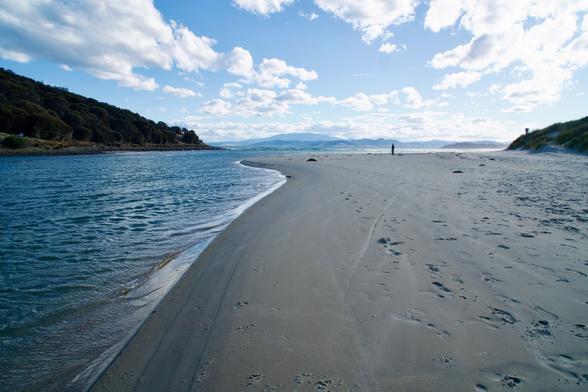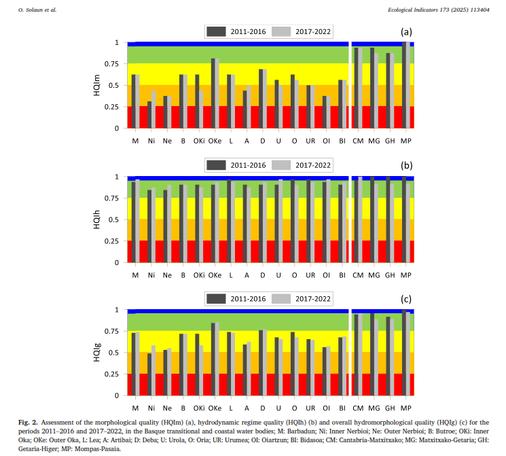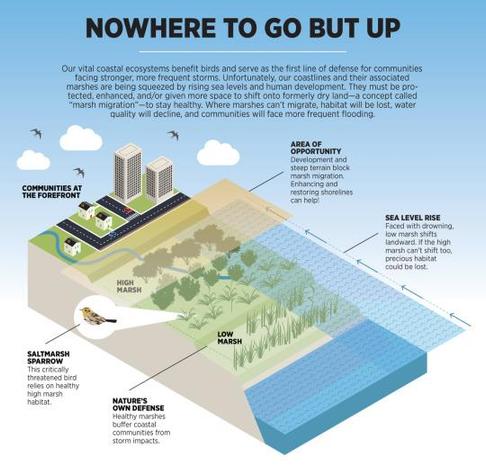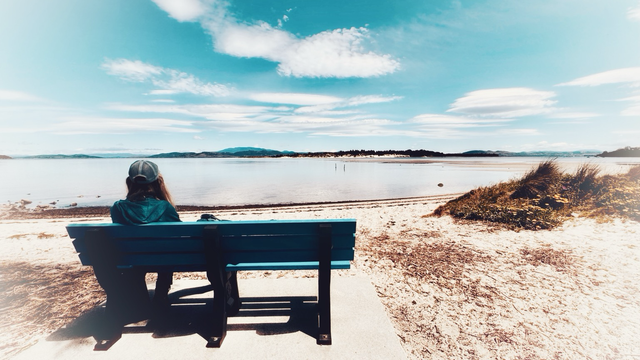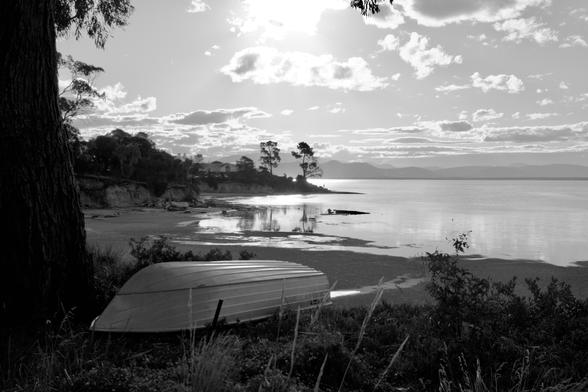Sussex Bay & Sussex Kelp Recovery Project
https://sussexwildlifetrust.org.uk/get-involved/projects/sussex-bay #Coasts #Sussex #WildLife #SolarPunkSunday #Volunteer #UK #Nature #BioDiversity #Community
#Coasts
23-May-2025
Study shows how #ElNiño and #LaNiña climate swings threaten #mangroves worldwide
https://www.eurekalert.org/news-releases/1084853 #science #environment #CoastalProtection #coasts #ecology #ClimateCatastrophe
20-May-2025
#CoastalSqueeze is bad for #biodiversity, and for us
https://www.eurekalert.org/news-releases/1084529
#science #ecology #coasts #SeaLevelRise #beaches #environment
last year's feature about #sand is now in the #openArchives. #FreeAccess for all. https://proseandpassion.blogspot.com/2024/05/all-about-sand.html #science #environment #beach #sustainability #coasts
Where the river meets the sea.
The Carlton River flows fast where to empties into Frederic Henry Bay on the southeast Tasmanian coast.
#tasmania #rivers #coasts #nature #photgraphy #landscapephotography
HT @btschumy
And this is why we need to #RethinkNotRestart and #ShutDownAllNuclearPlants -- especially the aging ones! This article outlines a very possible #Doomsday scenario -- but it could be a number of things, including a large #SolarFlare...
2030 Doomsday Scenario: The Great #Nuclear Collapse
A timeline of the #EndGame for human civilization
"Humanity has constructed a doomsday Deadman switch that threatens civilization. Climate destruction will make it increasingly difficult to avoid the looming global nuclear catastrophe we've created.
"Here's how our future might unravel:
Late 2020s: Climate Red Alert and Infrastructure Strain
"By the late 2020s, Earth’s climate is in unprecedented turmoil. Global average temperatures are consistently 1.5 °C above pre-industrial levels. Each year brings record-breaking heatwaves, “freak” floods, and droughts that batter infrastructure. Coastal cities flood more frequently, roads buckle in extreme heat, and power grids strain under surging demand for cooling.
"This cascade of climate disasters sets the stage for a systemic collapse: as societies grapple with runaway warming, the resilience of #Criticalnfrastructure (power, water, transit) erodes.
"Energy systems enter a crisis even before 2030. Nuclear power, which in 2025 still provided about 9% of the world’s electricity from ~440 reactors, becomes increasingly unreliable. Many nuclear plants struggle with climate stresses: cooling water sources heat up in summer, forcing reactors to reduce output or shut down to avoid unsafe temperatures. For example, a 2028 European #heatwave pushes river and sea temperatures above 25 °C, triggering emergency shutdowns at multiple reactors that cannot be cooled effectively.
"At the same time, stronger storms and floods threaten reactor safety. Dozens of reactors worldwide are unprepared for #ExtremeFlooding, meaning a dam failure or #StormSurge could lead to a Fukushima-scale accident. Worrisome reports emerge of power plants in #floodplains and #coasts where defenses are overtopped by #RisingSeas and torrential rains.
"By 2029, global carbon output remains high, and natural feedback loops are kicking in. In the Arctic, permafrost thaws and releases methane creating a vicious warming cycle where initial warming triggers more emissions, leading to even more warming. Scientists caution that a tipping point is near, beyond which climate change becomes self-perpetuating (a true “runaway” scenario).
"Society approaches 2030 in a precarious state: aware of looming catastrophe yet unprepared for its speed. The stage is set for the coming collapse, with power grids and nuclear facilities - the backbone of the industrial world - already under severe strain.
Early 2030s: Blackouts and the First Reactor Crises
"2030 marks the breaking point.
"A confluence of climate catastrophes collapses power grids across multiple continents. A severe global heatwave in the summer of 2030 brings record electricity demand while many power plants (nuclear and coal alike) are derated or offline due to overheating coolant water.
"Then powerful Category 5 storms strike in succession: one hurricane inundates the U.S. Eastern seaboard, while an unprecedented typhoon swamps Southeast Asia. These #disasters knock out transmission lines and flood key substations, leading to prolonged blackouts in dozens of major cities. Emergency systems are overwhelmed. With communications down and transportation paralyzed, manpower shortages become acute - many operators and engineers cannot reach their stations.
"Nuclear power plants are among the first to feel the emergency. Grid failure triggers automatic reactor SCRAMs (rapid shutdowns) at plants from Florida to France. Control rods halt the fission reactions, but decay heat in reactor cores still needs cooling for days to prevent meltdown.
"Normally, backup diesel generators would power the cooling pumps, but the scale of the #blackout means diesel resupply is uncertain and some generators fail in flooded facilities. In a grim reflection of 2011’s Fukushima disaster, several coastal reactors lose all power as storm surges drown their backup generators.
"Within hours to days, the first meltdowns occur.
"In 2031, a reactor in South Asia becomes a flashpoint: its cooling pumps falter after the grid collapse, leading the core to overheat. The reactor’s heart melts through containment in a matter of days, releasing a plume of radioactive steam and debris.
"Nearby, an even greater danger unfolds: the plant’s spent fuel pool, packed with years of highly radioactive spent rods, boils dry without cooling. Exposed to air, the zirconium cladding of the fuel ignites, triggering a fire that belches long-lived radioisotopes directly into the atmosphere. This nightmare scenario - once narrowly avoided at #Fukushima by heroic ad-hoc measures - now plays out in full."
Read more:
https://www.collapse2050.com/2030-doomsday-scenario-the-great-nuclear-collapse/
#NoNukes #RenewablesNow #ClimateChange #ClimateCrisis #Radiation #NuclearMeltdowns #Polycrisis #NoMoreFukushimas #NoNukesForAI #CivilizationCollapse #NuclearFuture #ARadioactiveWorld
15-Apr-2025
Coastal #heritage threatened by climate change
Humans have always lived by #coasts and #waterways, and thus these locations are rich with #archeological sites. Natural and cultural resource management are conducted separately, despite the fact that climate change, #seaLevelRise, and #extremeWeather threaten them both.
Do you need to assess the #hydromprphological status of your #estuaries and #coasts? read our paper for free and apply it for the #WFD Water Framework Directive #MarineEcology @azti.bsky.social #URAGENTZIA #Research authors.elsevier.com/sd/article/S...
Listen… hear that? They are coming… the big black yellow-tailed cockatoos that swoop by so low that you can almost reach out and touch them. And… there they are winging their way across the bay as the setting sun casts its red-shifted light onto the clouds.
In the colder months the cockatoos come by in flocks numbering well into the tens. Only a few make their passage today.
SQUARK SQUARK SQUARK… their loud and raucous call fades into the distance as they head for wherever it is that black cockatoos spend the night.
#nature #naturephotography #sunsetphotography #photography #birds #cockatoos #coasts #wildlife #Tasmania
Kerala’s eroding edge: a coast in crisis https://timesofindia.indiatimes.com/city/kochi/keralas-eroding-edge-a-coast-in-crisis/articleshow/117345447.cms #ClimateEmergency #Coasts #Kerala #India
New IUCN report provides guidance for conserving land, water and coastal areas https://iucn.org/story/202501/new-iucn-report-provides-critical-guidance-conserving-land-water-and-coastal-areas #Land #Water #Coasts #IUCN
🫧 Protective salt marshes along coasts are in danger across the globe but it's not too late to act, researchers say
https://phys.org/news/2024-12-salt-marshes-coasts-danger-globe.html
‘Ironic’: climate-driven sea level rise will overwhelm major oil ports, study shows https://www.theguardian.com/environment/2025/jan/04/climate-driven-sea-level-rise-set-to-flood-major-oil-ports?CMP=Share_iOSApp_Other #ClimateChange #Coasts #Oil
Mangrove trees meet, and beat, hard infrastructure for coastal resilience
#trees #forests #reforestation #afforestation #greeninfrastructure #infrastructure #nature #natural #conservation #natureconservation #resilience #sustainable #sustainability #coastal #coasts #florida #climatechange #floodcontrol
https://www.triplepundit.com/story/2024/mangrove-planting-programs/815236
Mangrove trees meet, and beat, hard infrastructure for coastal resilience
#trees #forests #reforestation #afforestation #greeninfrastructure #infrastructure #nature #natural #conservation #natureconservation #resilience #sustainable #sustainability #coastal #coasts #florida #climatechange #floodcontrol
https://www.triplepundit.com/story/2024/mangrove-planting-programs/815236
5-Dec-2024
#Mangroves save $855 billion in #floodProtection globally, new study shows
UC Santa Cruz researchers highlight critical role of mangroves in coastal #resilience
https://www.eurekalert.org/news-releases/1067292 #science #ClimateCatastrophe #SeaLevelRise #environment #coasts
It is late afternoon on the bay. The setting sun reflects brightly off the waters, casting the land into silhouette. This is a quiet time in southeast Tasmania.
Due to the contrasting light the image worked better as black and white than colour.
#Tasmania #coasts #photography #landscapephotography #blackandwhitephotography
